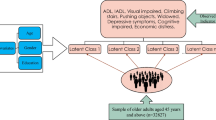Abstract
Age and gender differences in ADL ability were investigated using 568 Japanese partially dependent older people (PD, Mean age=82.2±7.76 years) living in welfare institutions. The subjects were asked about 17 ADL items representing 7 ADL domains by the professional staff working at subjects' institutions. Each item was assessed by a dichotomous scale of “possible” or “impossible”. Item proportions of “possible” response were calculated for gender and age groups (60s, 70s, 80s and 90s). Two-way analysis of variance (ANOVA) using the arcsine transformation method indicated no gender differences. Significant decreases in ADL ability with aging were found in 13 of the 17 items. The dependency of ADL in the PD significantly increases with aging, and there is no significant difference in this trend between men and women. The dependency of more difficult activities using lower limb increase from the 70s, and independency of low-difficult activities such as manual activities, feeding and changing posture while lying is maintained until the 80s and over.
Similar content being viewed by others
References
Demura S, Sato S, Kobayashi H, Kasuga K, Toyoshima Y. Development of ADL index for partially dependent older adults. Japanese Journal of Public Health 1999; 46-1: 25–34.
Sonn U, Asberg KH. Assessment of activities of daily living in the elderly. A study of a population of 76-year-olds in Gothenburg, Sweden. Scandinavian Journal of Rehabilitation and Medicine 1991; 23: 193–202.
Sutthichai J, Pirom K, Shah E. The meaning of activities of daily living in a Thai elderly population: development of a new index. Age and Ageing 1994; 23: 97–101.
Tsuchiya K, Imada H, Okawa T. Activities of daily living. Tokyo: Ishiyaku Publishers, Inc., 1992, 1–52. (in Japanese).
Itoh T, Kamakura N. ADL (activities of daily living) and related social problems: practical approach to assessment, guidance, and patient care. Tokyo: Igaku Shoin, 1994, 1–53 (in Japanese)
Ranberg KA, Christensen K, Jeune B, Skytthe A, Vasegaard L, Vaupel JW. Declining physical abilities with age: a cross-sectional study of older twins and centenarians in Denmark. Age and Ageing 1999; 28: 373–377.
Dunlop DD, Hughes SL, Manhein LM. Disability in activities of daily living: Patterns of change and a hierarchy. American Journal of Public Health 1997; 87: 378–383.
Klein MR, Bell B. Self care skills: behavioral measurement with Klein-Bell ADL scale. Archives Physical Medicine and Rehabilitation. 1982; 63: 335–338.
Mahoney FI, Barthel WD. Functional evaluation: The Barthel Index. Maryland State Medical Journal 1965; 14: 61–65.
Shoening HA, Iversen IA. Numerical Scoring of Self-care Status: A Study of Kenny self-care evaluation. Archives Physical Medicine and Rehabilitation 1968; 49: 221–229.
Lawton MP, Brody EM. Assessment of older people: self-maintaining and instrumental activities of daily living. Gerontologist 1969; 9: 179–186.
Koyano W, Shibata H, Nakazato K, Haga H, Suyama Y. Measurement of competence: reliability and validity of the TMIG index of competence. Archives of Gerontology and Geriatrics 1991; 13: 103–115.
Keith RA, Granger CV, Hamilton BB, Sherwin FS. The Functional Independence Measure: a new tool for rehabilitation. In: Eisenberg MG, Grzesiak RC editors. Advances in clinical rehabilitation. Vol. 2. New York: Springer, 1987: 6–18.
Kempen GIJM, Suurmeijer JPBM. The development of a hierarchical polychotomous ADL-IADL scale for noninstitutionalized elders. Gerotologist 1990; 30: 497–502.
Hosokawa T, Tsubono Y, Tsuji I, Maesawa M, Nakamura R. Assessment of functional status with an extended ADL scale (1) A general population sample of community elderly. Japanese Journal of Rehabilitation and Medicine 1994; 31: 399–408 (in Japanese).
WHO. International Classification of Impairments, Disabilities and Handicaps, Geneva: WHO, 1980.
Lamb VL. Gender differences in correlates of disablement among the elderly in Egypt. Soc. Sci. Med. 1997; 45: 127–136.
Bowling A, Grundy E. Activities of daily living: changes in functional ability in three samples of elderly and very elderly people. Age and Ageing 1997; 26: 107–114.
Winograd CH, Lemsky CM, Nevitt MC, Nordstrom TM, Stewart AL, Miller CJ, Bloch DA. Development of a physical performance and mobility examination. Journal of the American Geriatries Society 1994; 42: 743–749.
Sato S, Demura S, Kobayashi H, Goshi F, Minami M, Nagasawa Y, Yamaji S. Characteristics of ADL ability on partially dependent older adults: Comparison among different ambulatory activities levels. Applied Human Science 1999; 18: 169–174.
Mahoney JE, Sager MA, Jalaluddin M. Use of an ambulation assistive device predicts functional decline associated with hospitalization. Journal of Gerontology 1999; 54A: M83-M88.
Author information
Authors and Affiliations
Corresponding author
Rights and permissions
About this article
Cite this article
Sato, S., Demura, S., Tanaka, K. et al. ADL ability characteristics of partially dependent older people: Gender and age differences in ADL ability. Environ Health Prev Med 6, 92–96 (2001). https://doi.org/10.1007/BF02897952
Received:
Accepted:
Issue Date:
DOI: https://doi.org/10.1007/BF02897952




